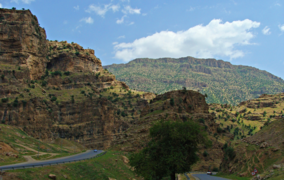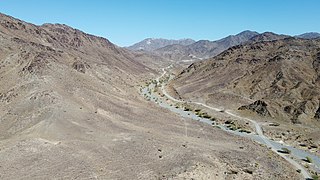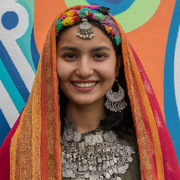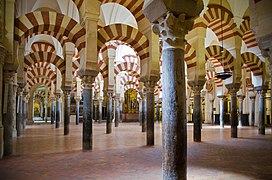Bulkh
Bulkh | |
|---|---|
|
Flag | |
Motto: والله زمان يا سلاحي It has been a long time, oh my weapon! | |
Anthem: File:Walla Zaman Ya Selahy.ogg | |
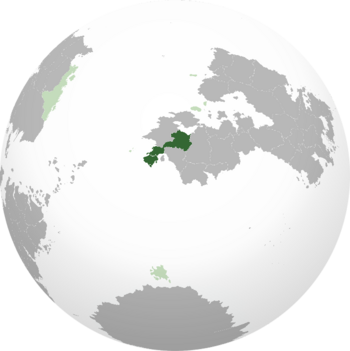 | |
| Capital | al Qadria |
| Demonym(s) | Bulkhiyeen |
| Government | constitutional republic |
• The Most Elected Minister | Rahani Bintuta |
• Co-President of Bulkh | Pasqual I |
| Area | |
• | 824,056.517 km2 (318,170.000 sq mi) |
| Population | |
• Estimate | 8,500,540 |
• Density | 10.315/km2 (26.7/sq mi) |
| GDP (nominal) | estimate |
• Total | $190,722,025,688.40 |
• Per capita | $22,436.46 |
| Date format | dd-mm-yy |
| Driving side | right side |
Bulkh, officially the Representative Republic of Bulkh, is a minor power sovereign country on the southwestern coast of the Daria region in Audonia, in a real union with Burgundie. It is bound by the Sea of Kandahar and Battganuur to the north, the Nassarine Bay and the Bulhkawan Bay to the west, the Bay of Oduniyye to the south, Pursat to the southeast, and Umardwal to the east. It came to its modern iteration after the Emirati War, in 1897 both geographically and politically. For its internal governance and policy Bulkh is a constitutional republic with consociational representation, shared between the Arab Muslim population, Bedouin nomads, and the polity of Christians. While suffrage is universal and by secret ballot, it is still common for voters to generally follow their tribal leaders lead on issues. For external policy, through its real union with Burgundie, Bulkh has a unanimous concessions requirement for the Constituent Council to deviate from Burgoignesc foreign policy, an option it rarely exercises and has never reached.
Bulkh is a member of the League of Nations, and the International Red Cross and Red Crescent Movement.
Its primary exports are crude oil, Construction aggregate, fish, and cork. It maintains a capitalist economy but with certain controls and subsidies around critical industries like food, water, energy, healthcare, and transportation, which are typically managed as a public-private ventures.
Many scholars have criticized its governance, economy, and politics, arguing that the real union with Burgundie makes Bulkh both a colony of Burgundie and also a dividing factor in the Daria region of Audonia. Proponents of the real union say it has brought prosperity and raised the standard of living significantly while also preserving the traditions of the Bulkhiyeen.
Geography
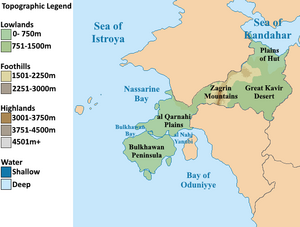
-
Farming in Bulkhan interior
-
Southern mountains, Baqunah Mountain Range
-
Wadi in the Great Kavir desert
-
Coastal community
Climate and environment
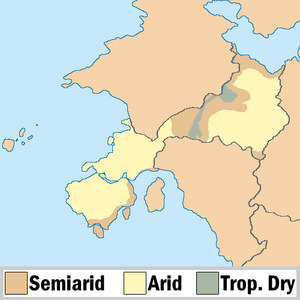
- Do: Temperate Oceanic
- Cf: Humid Subtropical
- Aw: Tropical Wet-And-Dry
- Bw: Desert or Arid
- Bs: Steppe or Semiarid
Bulkh, along with Burgoignesc, Battganuur, and Pursat is working on a largescale greening, rewilding, and de-desertification project to reclaim arable land from the Great Kavir called the Great Green Wall.
History
Prehistory
It's estimated that the first settlements in the modern area of Bulkh were settled around 10,000 BCE. These settlements were primarily in the interior where the Great Kavir desert is today. Some 5,000 years ago, the area was not so arid and the vegetation might have been closer to a savanna. However, desertification set in around 3000 BCE, and the desert became much like it is today. This desertification pushed the people further south into what is now the known as the Bulkawan Peninsula by 4500 BCE. The interior had become mostly uninhabited by 500 BCE, and the coasts had become the primary areas of both settlement and cultivation of crops. There was still bands of nomads in the desert interior but not nearly to the same extent that there had been two or 3,000 years prior. These coastal settlements became more and more settled as the cultivation of grains and the raising of goats and sheep in the grasslands became more sustainable for the larger populations.
Classical Antiquity
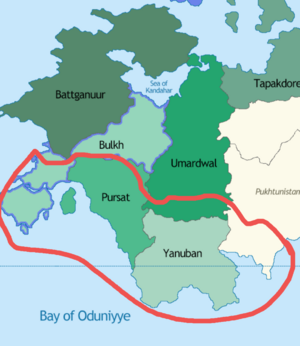
-
The Great Stones
-
Remnants of the Great Library of Kussaipis
-
Ruins of the power naval city Aknosheh
In the 9th century BCE, the Kemeti people rose to prominence as a regional power, establishing trade networks with neighboring civilizations and developing a sophisticated system of writing based on hieroglyphs. The Kemeti pantheon, featuring gods like Re, the sun god, and Isus, the goddess of fertility, became central to Kemeti religious life. During this era, monumental structures like the Great Stones and the Temple of Amin were constructed, showcasing the Kemeti's architectural prowess. They were great slavers and traders of fine goods all along the Bay of Oduniyyad and they were also connected into the Sea of Istroya trade network. As desertification of the Great Kavir pushed some closer to the coast, the Kemeti became war-like and centralized capturing most of modern Bulkh, Pursat, Yanuban, parts of southern Umardwal, and Syliria. The Kemeti dominated the local Arabs and Pursi people.
By the 7th century AD, the once-mighty Kemeti civilization had endured millennia of prosperity and dominance. However, internal strife, political instability, and the pressure of neighboring empires had gradually weakened the Pharaonic state. The final dynasty, the Pe-ankh-em-tanenids, weakened by corruption and economic decline, struggled to maintain control over its vast territory. In 739, the armies of the Oduniyyad Caliphate, set their sights on the Kemetis. Led by the brilliant general 'Amr ibn al-'As, the Arab Muslim forces swiftly crossed the frontier and engaged the Kemeti army at the Battle of Fapohdet. Despite their valiant efforts, the Kemeti forces were no match for the disciplined and highly motivated Arab Muslim army. The defeat at Fapohdet marked the beginning of the end for the Kemeti civilization.The Oduniyyad Caliphate forces continued their advance, capturing major cities and fortresses across the . In 842 AD, the cultural and intellectual heart of the Kemeti civilization, Medvasut, fell to the invaders. The Great Library of Kussaipis was burned down by the rampaging Caliphal forces marking the end of the Kemeti civilization, at least as a centralized state. Remnants of the Pharaonic retinue and army fight for three more years but they were never victorious and the Pharaoh Atemu III died, alone in the streets, in 843, his family and heirs all killed by the Oduniyyad Caliphate.
Medieval period
Oduniyyad Caliphate and Arabization
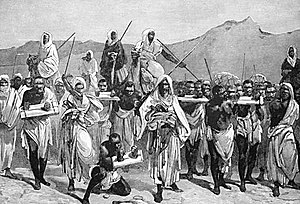
The Bedouin peoples of the Bulkawan Peninsula were resistant to the spread of Islam and conquest by the Oduniyyad Caliphate. While the Caliphs claimed the land as their own, they were never able to formalize the government and taxation system to bring the Bedouin peoples to heel. During the 900s the Caliphate attempted to migrate some Najdi Arabs from the northern deserts of modern day Bulkh and to the area to punish the recalcitrant Bedouins. The Umardi princes brought their culture to the area, but following the Shia schism they remained Sunni, one of the few ethnically Umardi ruled areas to do so. The Bulkawan Peninsula remained segregated between a Umardi ruling class and a Bedouin population until the fall of the Caliphate. At this point the Umardi princes were expelled back to Umalia and the various Bedouin tribes retired back into their nomadic lifestyles.
Salt and slave trades
Decline of the Caliphate and the Warlords Period
Early modern era
Following the collapse of the Caliphate the various Bedouin tribes retired back into their nomadic lifestyles. The area remained untouched until the arrival of the Kiravian and NATION colonial efforts in the 15somethings.
Istroya Oriental colony
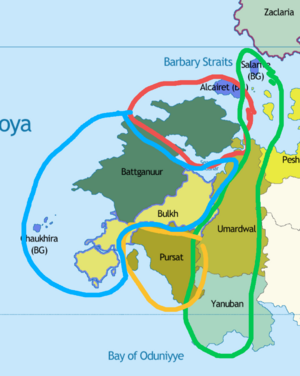
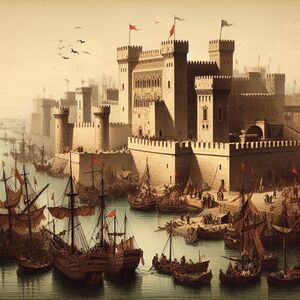
The area being arid was of little use to colonists. They moved on and found other more temperate sites for settlements in the late 1570s. From 1578-1614 there was no recorded colonial activity in the area. However, in 1615 a Martillien North Levantine Trading Company (MNLC) surveyor mapped the salt flats of the Chott al-Rezid and the company made a mad dash to secure the area.
Company rule
Due to their nomadic lifestyle and their disinterest in engaging the occidentals, the Martillien North Levantine Trading Company (MNLC) largely left the Bedouins of the Bulkawan Peninsula alone and built their colonies around them. By the 1630s timber from Majanub was being brought to build a sprawling complex of fortified towns and salt mining operations. Businesses to support the efforts became very lucrative and wainwrights, shipwrights, and engineers flocked to the area. Beyond the Chott al-Rezid the Company build operations at the Chott al-Mouza and the Ben Ghilli Salt Flats. These operations brought millions into the Company’s coffers and is one of the primary financial activities that allowed for unfettered expansion in Audonia. The salt mines brought tens of thousands of colonists from Burgundie, the Levantine Protestant communities on Torlen and Medimeria, as well as from other parts of Audonia. The port cities of Avelie and Sant Marten both surpassed 20,000 residents in the 1690s making them bigger than Vilauristre and Port Diteaux. The back-breaking work and the blistering heat made for a seedy type coming to seek work in the colonial province of Bulkawa. This led to rapid development of the vice sectors like prostitution and drinking halls. It also required the establishment of a vast drinking liquid network. This drove the development of the tea plantations in Vitale, Pukhgundi, and other parts of Audonia.
In the Presidency Act of 1771, the Presidency of Bulkhawan was announced, covering much of the eastern Istroya Oriental colony but ceded some of the desert interior to the nomads as they were pushed out and forced to renounce their nomadic traditions. This led to intense bad blood between the colonial state and the locals. Colonial Battganuuri knights were brought into to escort the Bedouins from their villages, but clashes erupted in a number of areas leading to the massacre of the tribal peoples. In the 840 recorded Bedouin encampments in the area with an estimated population of 969,000 people, only 694 encampments and 539,000 people were successfully relocated. The remainder were assumed killed or dispersed into the vast desert waste. The brutal effectiveness of this dispossession of tribal homelands become a model for colonial powers post-independence powers for centuries afterwards. These “Trails of Trauma” paved the way for a huge boom in colonial growth and land redistribution. Vast areas formally reserved for the Bedouin were settled and huge irrigation projects were started to reclaim parts of the desert that were adjacent to littoral areas. There was even an ambitious plan to dredge a channel to the salt-stripped Chott al-Mouza in 1793 that was never realized.
Following the start of the Great Slavers Bay Rebellion, a similar call to arms led the Bedouins to unite under Ali Malik, becoming known as Malikites, a proto-communist who wanted to rid the Bulkawan Peninsula of colonial influence and establish a collective paradise. Malik gathered a force of 20,000 Bedouin cavalry and rode south to forcibly gather support for his attempts. The following year, 1824, he returned with an army of 250,000. It is unclear if these reports are just of combat troops or included his train, regardless it was a sight to behold. The colonial troops balked and retreated with each engagement and the few occidental soldiers and officers did their best to forestall the inevitable. Fearing the loss of their capital and the salt mines, the Company hastily made treaties across Audonia and redirected its troops to Presidency of Bulkhawan. A force of 45,000 colonial troops was formed and force-marched through the desert to meet the Malikites head-on. Arriving at the western edge of the Great Kazir desert in March of 1825, the colonial army set about building a camp and reinforcing its supply lines. The massive, cumbersome western-styled army immediately fell prey to the sprightly and spirited, lightning-fast raids of the Malikite army. Their supply lines disrupted and their supply of food and water dwindling, they made a forced march to the southern coast. 540 men died of starvation and thirst along the way, but the remainder were met by the navy and brought back to Sant Marten. As equatorial winter set in all they decided to wait. Garrisons were established at the salt mines and some recently created farming communities were forcibly abandoned and the men impressed into a militia. January of 1826 saw the first attempts by the Malikites to probe the defenses of the colonial forces. The Ben Ghilli Salt Flats came under attack January 12th. A small detachment of Malikite cavalry attacked the forward watch posts and were met with cannon fire from the fortified town. A squadron of Battganuuri knights and Umardi Sipahis were dispatched to try to find the main Malitike force.
Late modern period
-
Bulkhawan fighters during the Second Great War, 1937.
The early 20th century in Bulkh saw the rapid adoption of Occidental memes such as industrialism, capitalism, urbanization, but development has been uneven, mostly occurring in its coastal regions. Following the First Great War, and especially after the Second Great War, Bulkh was rapidly increased its adoption of secularism, and democracy and its cultural and economic ties with Burgundie. The nation signed a constitution in 1906 and became a secular republic. This government set about a series of invasive modernization policies that were not popular, but any resistance was quashed by a corrupt but loyal police force and army. During the Second Great War Burgundie and Bulkh were allied against the anti-colonial powers of Audonia and Alshar and this arrangement made the government and elite incredibly rich.
Contemporary period

The income disparity as well as the Occidentalization from the first half of the 20th century caused a rift in the nation that ultimately led to a communist insurgency in the western part of the country during the 1960s-80s. During this period the government further embraced Burgundie and became a rising star in the globalizing world. It has become a stable global trading partner for nations and has developed a strong manufacturing sector that rivals any in the Middle seas region. Today, Bulkh is a key second tier manufacturing hub for industrializing nations and nations with moderate and lower incomes. It is also serves as a point of power projection for Burgundie in the Audonia/Alshari interface zone, through which it also conducts its own modest power projection.
Bulkh People's Republic
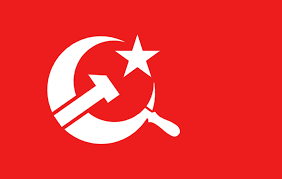
In 1964, communist insurgents from Umardwal spilled into the eastern provinces of Bulkh and established a People's Republic. Federal forces attempted to route the insurgents but the vast desert and lack of development in the region led to a long and tedious campaign of attrition. A formal People's Republic of Bulkh was accepted by a referendum of the people of the western provinces in 1968. At this time the Burgundie extended Operation Kipling to include the Bulkh People's Republic.
From 1968-1982 the Bulkh People's Republic (BPR) was a break away region of Bulkh that hosted its own Agraro-Islamic socialist government and society. It rose in opposition to the increasingly urbanist, industrialist, and capitalist society that was forming in the aftermath of the Second Great War. Its center of power was in the market settlement of Tall Diwabjah. Despite its aims, the BPR was never successful in its attempts to fully realize its socialist ideals as it occupied mostly inarable, inhospitable desert and was, from 1974 until its defeat in 1982, constantly at war with government forces.
The BPR was more of a political movement than a defacto state and the population it oversaw were largely Bedouin nomads and transient herders who owed no particular allegiance to the BPR's government. It did get some international recognition from other communist and socialist states but it was never seriously considered by most nations, the Loan, and had no trade arrangements with any other states. In its own internal census of 1980 it reported to have a population of 325,493 people, but the government of Bulkh has never reported more than 25,390 people in the areas under BPR control in the 1965 or 1985 censuses of the regions.
The BPR did enact a number of land-use policies that took away what nascent private property laws had been enacted in the early 20th century, but their was very little privately held property in the regions they controlled so these reforms were largely symbolic. The government created a Revolutionary Peoples Liberation Army which boasted, on average, 5,000 troops and a further 15,000 guerillas. While not significant in number these troops were enough to engage, confound, and occasionally defeat the Army of Bulkh throughout the 70s.
Government and Politics
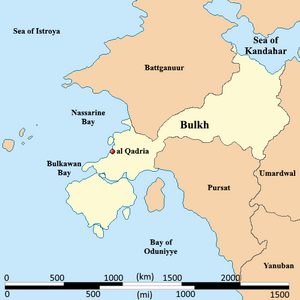
Bulkh is a secular Consociational democratically elected oligarchic state with power being shared by the elites of the majority Muslim Arab community (68% of the population) and the minority Christian (20% of the population) and Bedouin (12% of the population) communities. Representatives to the Constituent Council are directly elected by their constituency and serve for a term of 3 years. There is a 4-term limit to service on the Constituent Council.
From within the elected members of the legislative body a Most Elected Minister is elected for a 6-year period to serve as the head of the executive branch. There are no term limits to the Executive branch.
Federal subdivisions

Buhlk is divided into 5 provinces and a Federal District.
- The Federal District of Zerhoun
- Tizi n-Anzar Province: Southern coastal region, capital Agadir n-Tin Hinan, largest city Ighil n-Aberkan
- Azemmour Province: Central coastal region, capital Asif n-Tighmert, largest city Tizi n-Teslit
- Agadir n-Ait Warain Province: Northern coastal region, capital Tamdint n-Tafukt, largest city Ighil n-Yemma Gouraya
- Tafraout Province: Northern half of the interior, capital Sidi Bou Zayid, largest city Dinzour
- Chefchaouen Province: Southern half of the interior, capital Touzuer, largest city Sidi Bin Saif
Military
-
Joint Burgo-Bulkh Iylia Airforce Base
-
Royal Air Service of Burgundie Fighter/interceptor Escadrille 3 of the Wind Scorpion Escadron
-
Burg and Bulkhawan fighters patrolling the Great Kavir.
The military of Bulkh is small but highly professional. It is comprised of three branches the Army (land), the Maritime Defense Force (navy and coast guard), and the Republican Escadrille (air force and ostensibly space force).
The Army had 5 brigades (3 infantry, 1 armored, and 1 air assault). It was reformed entirely during Operation Kipling eschewing many archaic and tribalistic traditions. It is viewed as the safeguard of secular republicanism and its traditions and virtues follow those concepts. The army's strategic objectives are all defensive in nature but it's air assault brigade has some minor expeditionary capacities, within a limited scope. It is postulated that Bulkh could launch expeditionary operations against Battganuur, Chaukhira, Pursat, Umardwal, and Yanuban, although sustainment would become an issue after a week of sustained fighting.
The Maritime Defense Force (MDF) is formed around 4 destroyer squadrons, with a total of 8 destroyers, 18 frigates, 29 frigates and avisos, 63 littoral patrol craft, 5 ocean going tugs, 2 hydrological survey ships, and 2 dredgers. It also has an amphibious assault craft and 3 replenishment oilers that it purchased from Burgundie in the late 1990s through the mid 2020s which constitutes its only expeditionary capability. The MDF also has a modest air wing with 13 fighter/torpedo bombers, 19 fighter/interceptors, 17 maritime patrol/meteorological survey aircraft, and 2 AWACS.
The Republican Escadrille is a force of 7 air wings, 4 fighter/interceptors wings, two fighter/bomber wings, and one AWACS/Electronic Warfare wing. The Escadrille also oversees the countries Strategic Forces and its arsenal of ICBMs, the true number is unknown, but it is estimated that it is around 47.
Society
-
Bulkhawani business man
-
Modern urbanite woman
-
Bedouin woman in traditional wear
-
Nadji woman in traditional wear
-
Bulkhawani children
-
Bulkhawani man playing an oud in the street
-
Bedouin girl
-
Bedouins making bread which is gonna be covered in sand, I can feel it in my teeth, I hate it.
With 65% of its 1.5 million residents concentrated in coastal cities. The largest ethnic group, comprising 68%, are Arab Muslims, further divided into subgroups like the politically powerful Umardi and the commercially engaged Najdi. Christians make up 20%, concentrated in the south and cities, while Bedouin groups account for the remaining 12%. Standard Arabic and Burgoignesc reign as official languages, while regional dialects and religious tongues are recognized within the states in which they occur. Islam, primarily Sunni, dominates religious practice, though Christianity maintains a strong presence. Society maintains a loose class system with a growing urban middle class, while Bedouin communities hold onto tight-knit tribal affiliations. Traditional gender roles persist, but progress towards women's empowerment is evident in recent years. Ethnic and religious tensions, social inequality, Bedouin integration challenges, and rapid urbanization's growing pains pose ongoing hurdles for Bulkh's diverse populace.
Religious demographics
Self-reported religious affiliation in Bulkh (2030)
Faith plays a central role in shaping Bulkh's social fabric. 68% of the population identifies as Muslim, primarily Sunni. However, nuanced interpretations and cultural practices create a diverse religious landscape. Christianity finds fertile ground with 20% adherence, with Mercantile Reform Protestantism and Catholicism forming the main denominations. Vestiges of the colonial past remain, with communities practicing Christian liturgical languages, like Latin.
Linguistic demographics
Standard Arabic serves as the official language, unifying discourse in government, education, and media. Regional dialects like Najdi and Wahanji Arabic resonate within their respective communities, while Bedouin groups preserve their unique heritage through diverse Arabic dialects. Burgoignesc, a reminder of the colonial era, remains present in pockets, primarily used in business and higher education.
Cuisine
-
Falafel plate
-
Kebab koobideh
-
Kibbeh
Common ingredients include olives and olive oil, pitas, honey, sesame seeds, dates, sumac, chickpeas, mint, rice and parsley, and popular dishes include kebabs, dolmas, falafel, baklava, yogurt, doner kebab, shawarma and mulukhiyah. The region was also influenced by dumplings from Dolong brought through the Silk Road; turmeric and other spices from Pukhgundi; cloves, peppercorns and allspice from the Spice Islands; okra from Kandara, and tomatoes from Crona.
Religion has impacted the cuisine by making lamb the primary meat since Muslims do not eat pork, and beef was sacred under the Arunid Empire and therefore it's cultivation never took off. Alcohol is Haram under Islamic law but young urban cosmopolitans do imbibe alcohol. Palm wine is locally produced but all other alcohols are imported.
Alcohol
Alcohol is Haram under Islamic law and temperance has been a central point of Mercantile Reform Protestantism at some points of the late modern period. These religious prohibitions, however, haven't eliminated alcohol consumption in Bulkh, especially in the 21st century, amongst a burgeoning population of young, occidentaly educated, urban cosmopolitans. Their once discreet defiance has become more overt in the last few decades and has given rise to a burgeoning drinking culture, thriving primarily in the bustling urban centers. Granquai Restaurant Chain has become a haven for young urbanites seeking to indulge in the sweet nectar of the Gods, hamdullah. While ostensibly serving a menu of local and international cuisine, Granquai's lounges features a place, discreetly tucked away from public view for these youth and offers a sense of community and liberation, away from the prying eyes of the generally conservative society. The young urban professional drinking scene in Bulkh extends beyond mere hedonism. It represents a generational shift, a quiet rebellion against stringent social norms. Young Bulkhiyeen, exposed to global influences through education and media, are increasingly questioning traditional values. Alcohol, in this context, becomes a tool of self-expression, a symbol of defiance against a conservative establishment.
Palm wine is made locally from the sap of palm trees. It predates Oduniyyad Caliphate's and Islam's arrival in the region and enjoys a degree of cultural acceptance, especially in the Bedouin community. Often associated with rural communities and traditional festivities, palm wine has been shielded from religious interference, but its alcohol content is artificially made lower out of respect for Islamic morays.
Architecture
Much of the ancient surviving architecture in Bulkh is comprised of the Islamic architectural style brought by the Oduniyyad Caliphate. Much of these are religious buildings like mosques and masjid and other are government buildings primarily in the large urban settlements that would become the cities along the coasts. In the [[early modern period, architectural influences came primarily from the Occidental world, especially the styles in Burgundie. These Levantine styles persisted and even after the collapse of the Burgoignesc colonial empire and a resurgence of Occidental architectural motifs became the norm, especially in the late 20th century, after Operation Kipling. However, in the 1990s until now there has been a revival of more classical building methods, local building materials, architectural motifs reminiscent of Islamic styles of the past. While most urban cores reflect the more Occidental styles of the late 20th century and early 21st century, other less densely populated areas are much more visually reminiscent of the previous architectural styles. In the most remote areas, in the northern part of the country, the nomadic lifestyle of Bedouins has led to an almost complete absence of permanent architecture and as those populations were settled in the 20th century with the influences of modernist architectural styles and thinking some of the buildings came to reflect the tent like structures used by the nomadic Bedouins.
Economy and infrastructure
Bulkh is an industrialized nation with a strong manufacturing sector. It's close ties with Burgundie have led to a number of agreements with has allowed Burgoignesc companies to establish manufactories in Bulkh while paying local salaries, however all manufactories must comply to Burgoignesc health and safety standards.
Manufacturing
Shipbuilding
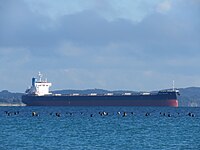

Unlike Burgundie's focus on technological marvels, Bulkh's shipbuilding industry carves its niche through affordability and practicality. Catering to companies and merchant marines from less advantaged nations, Bulkh prioritizes building reliable and cost-effective vessels like workhorse bulk carriers, efficient tugboats, and specialized cable layer for underwater infrastructure. Their offshore support vessels, ranging from Platform Supply Vessels (PSVs) to Multi-Purpose Support Vessels (MPSVs), cater to diverse offshore activities, all constructed with adaptability and affordability in mind. This strategic focus resonates with their diverse clientele. Regional shipping companies operating within neighboring countries or the Daria region find immense value in Bulkh's cost-effective solutions tailored for regional trade routes. Similarly, emerging market players seeking to build their initial fleets for global market entry rely on Bulkh's affordability. Independent operators and even NGOs benefit from Bulkh's ships, allowing them to participate in maritime trade without breaking the bank. The industry even boasts a history of cooperation with NGOs, building affordable vessels for humanitarian aid and disaster relief efforts. Bulkh's competitive edge hinges on several factors. Firstly, affordability remains paramount, achieved through access to readily available materials and labor, keeping prices lower than Western counterparts. Secondly, adaptability plays a crucial role, with shipyards readily customizing designs to specific client needs within their capabilities. Additionally, shorter lead times are a major advantage, thanks to simpler designs and streamlined processes. Finally, government support acts as a catalyst, offering subsidies and tax breaks to further incentivize shipbuilding in the country. However, challenges loom on the horizon. Modernization is crucial to remain competitive in the long run, demanding investments in cutting-edge technology. Environmental regulations also necessitate ongoing upgrades and adaptations to meet stricter standards regarding emissions and waste disposal. Furthermore, emerging competition from other developing nations entering the sector increases pressure to innovate continuously.
Shipwrights in Bulkh

- Dar Al-Bahr Shipyards: Located in the bustling northern port city of Aaqira, Dar Al-Bahr is a state-owned enterprise known for its large-scale bulk carriers and tankers. They boast a long history and employ thousands of skilled workers, making them a cornerstone of Bulkh's shipbuilding industry.
- Emirates Marine Consortium: Situated in the heart of the industrial zone of Aaqira, this Bulkho-Burgoignesc consortium brings together several smaller shipyards, leveraging their combined expertise to build offshore support vessels like PSVs and MPSVs. Their collaborative approach allows them to handle complex projects and cater to diverse offshore needs.
- Al-Noor Shipyard: Operating in the southern coastal town of Daylah, Al-Noor specializes in building cable layers and other specialized vessels for underwater infrastructure projects. Their commitment to precision and adherence to international standards makes them a preferred choice for sensitive marine operations.
- Khalid Bay Shipyard: Nestled on the shores of the scenic Khalid Bay, this independent shipyard specializes in building smaller, fuel-efficient vessels like tugboats and fishing boats. Their focus on innovation and customization attracts clients seeking agile and cost-effective solutions.
- Phoenix Shipyard: This family-owned shipyard, located in the historical southern port of Qalat, has a long tradition of building small, wooden dhows for traditional fishing and coastal transportation. Their focus on preserving this cultural heritage while incorporating sustainable practices sets them apart.
Construction aggregate

Bulkh has a massive sand mining and elutriation industry in support of its construction aggregate industry. It cultivates and exports 4.8 megatonnes of sand and silica. Bulkh also has gypsum mining the excavates 12 million tonnes of the substance. These aggregates are exported or combined in concrete dry-mix, and cinderblocks and sold premixed and packaged around the world.
Defense manufacturing
The AMY-Gerin-Lajoie Contract Maintenance Plant is a Burgo-Darian Mercantile Port Corporation funded manufacturing plant in Tamdint n-Tazart, Bulkhawa province, that is a joint venture by AMY from Yonderre and Gerin-Lajoie Weaponeering from Burgundie to manufacture parts to support and sustain the arms contracts that those countries maintain with armies in Daria. The plant is also used by the Army of Burgundie and the Army of Yonderre as an alternate production facility in the event of a national emergency.
Agriculture
Although Bulkh is mostly arid, the nation is a major agricultural producer and exporter, with over 325,300 employed in agriculture, forestry and fishing. Because of the climate the largest agricultural subsector is grazing (sheep, goats, and Zebu cattle) in the large semiarid zones. Across the country there is a mix of irrigation and dry-land farming. Plantation farming for crops like tea, rice, sugar, and rubber exist in the heavy rainfall coastal zones but the heavy winds from the interior desert keep much of the moisture restricted to the coast. Pisciculture is also a formidable subsector with sizable domestic and deep-water fleets, farms, and sustenance communities. The success of Bulkh to become a major agricultural power despite the odds is facilitated by its policies of long-term visions and promotion of agricultural reforms that greatly increased the country's agricultural industry.
olives and olive oil, pitas, honey, sesame seeds, dates, sumac, chickpeas, mint, rice and parsley.
Infrastructure
Air
Bulkh has two international airports the Malik International Airport in metro al Qadria, serving the southern half of the country. The other is Bi-smi llah Intermodal Transit Centre which is a commercial air, rail, and passenger ferry hub that serves the northern part of the country and the southeastern coast of the Sea of Kandahar.
| Name | Location | Type | Brief description | Code(s) | Picture |
|---|---|---|---|---|---|
| Malik International Airport | Passenger and cargo | 24/7/365 air traffic control operations, 3x runways, capable of receiving all airframes, cargo terminal, passenger terminal, complete maintenance facilities, integrated customs and border control service | ATRO: AMB
ICAO: AMBH |
 | |
| Bi-smi llah Intermodal Transit Centre | Passenger and cargo | 24/7/365 air traffic control operations, 2x runways, capable of receiving all airframes, cargo terminal, passenger terminal, complete maintenance facilities, integrated customs and border control service | ATRO: ABB
ICAO: ABBH |
 |
Rail
Bulkh uses Standard gauge, 1,435 mm (4 ft 8+1⁄2 in) as most of its rail infrastructure has been under the auspices of Burgundie and its sphere of influence in the Middle seas region, who all use that rail gauge.
A single-track railway serves as the backbone of Bulkh's rail infrastructure, primarily transporting bulk goods like minerals and agricultural products from north to south. Branch lines extend to specific industrial hubs and mining regions, playing a crucial role in resource transportation. However, the limited network coverage hinders regional development, and the aging infrastructure calls for modernization to improve speed, safety, and capacity. Despite these challenges, future plans are in motion. Ongoing projects aim to modernize existing lines with sustainable materials and climate-resilient designs, while ambitious expansion plans seek to connect more cities and facilitate regional trade. Public-private partnerships as well as foreign investment, primarily from Burgundie are seen as key to securing the funding and expertise needed to transform Bulkh's rail network into a robust and inclusive force for the future. 2,556 kilometers of Bulkh's rail system is owned and operated by Umardo-Tapakdori National Rail, which is funded by the governments of Tierrador and Burgundie.
Roads
National highways face the constant battle against harsh desert conditions and resource limitations. Secondary gravel roads serve smaller towns and communities but succumb to seasonal flooding. These unpaved local roads provide crucial last-mile connectivity, yet navigating them, especially during rains, can be hazardous. A major contract has been signed with Estia-Odoneru Gypsum, Salt, and Aggregate and O'Shea Industrial Services to extend the paved infrastructure to many villages in exchange for exclusive rights to the vast aggregate resources available in the country.
Louage
A louage is a minibus shared taxi in many parts of Daria that were colonized by Burgundie. In Burgoignesc, the name means "rental." Departing only when filled with passengers not at specific times, they can be hired at stations. Louage ply set routes, and fares are set by the government. In contrast to other share taxis in Audonia, louage are sparsely decorated. Louages use a color-coding system to show customers what type of transport they provide and the destination of the vehicle. Louages with red lettering travel from one state to another, blue travel from city to city within a state, and yellow serves rural locales. Fares are purchased from ticket agents who walk throughout the louage stations or stands. Typical vehicles include: the MILCAR Jornalero, the TerreRaubeuer Valliant 130, and the CTC M237-07.
Energy and electricity

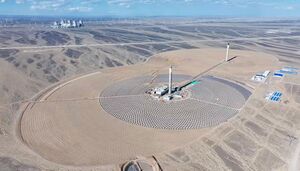
In 2024, Bulkh and Burgoignesc Gaia Energy Corporation, completed a 4,660-acre solar park and battery project. It consists of 875 megawatts (MW) of solar and 3,320 megawatt-hours (MWh) of energy storage.
See also

